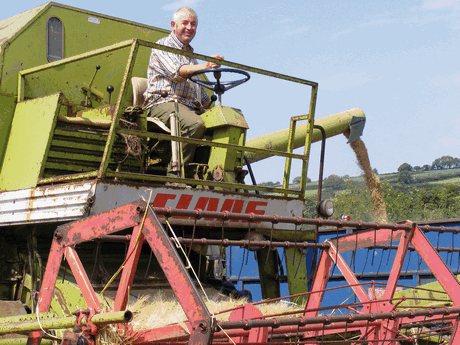Management Matters: Uncertain future for cereal production

Soaring costs of production for all commodities mean Martin Howlett is facing some difficult decisions at Deer Park Farm. Olivia Cooper reports
Harvest is under way, but with input costs continuing to rise, Martin Howlett is less than optimistic about the future for cereal production at Deer Park Farm.
“We want to continue to be as self-sufficient as possible,” he says. “But with the extra variable costs, we need to have a 5t/ha (2t/acre) crop to break even, with barley at £120/t.” Mr Howlett’s barley usually averages 5.5t/ha (2.25t/acre), so there is not much margin for error.
However, harvest is looking good so far, even if it has been interrupted by rain. The 4ha (10 acres) of Sequel winter barley cut, using Mr Howlett’s 1970 Claas combine, averaged 6.2t/ha (2.5t/acre). “That is 10% up on previous years,” he says.

Harvest is off to a good start, but Martin Howlett has concerns over the long-term future for cereal production
It also came in dry, at 14.4% moisture – an advantage with the lack of any drying equipment at the farm. The straw yield was also good, at 2.5t/ha (1t/acre). “At £72/t delivered – which is what we’ve bought extra straw in at – that is worth at least half a tonne of grain,” says Mr Howlett.
Although more than £25/t dearer than last year, he has already booked 45t of straw to see the cattle through the winter. “We fear prices will go up more – if the rain continues growers will struggle with quality. Also, with the price of fertiliser, more arable producers are chopping straw to make the most of its residual value.”
Despite rain over the past week, Mr Howlett is happy with harvest progress. “We’re not too far behind yet.” He still has 9.7ha (24 acres) of Saffron winter barley, 2.4ha (6 acres) of Mascani winter oats and 2.4ha (6 acres) of Fuego spring beans to cut. That will be followed by Belouga and Leeds maize and 12 maize trial plots.
“Everything is looking good. The longer-term worry is whether the quality will be affected if the rain continues, and whether grass weeds will proliferate and increase the crops’ moisture content.”
Mr Howlett is not convinced by the economics of cereal production in the long term. “Our costs of growing winter barley this year were £482/ha (£195/acre) – and we bought our fertiliser early. With the increase in fertiliser prices and other costs I’m not sure it still stacks up.”
On top of that, his preferred varieties are becoming difficult to source, as are some sprays best-suited to the Cornish climate. The proposed EU ban on sprays will compound this problem, he says. “It is going to be serious if it goes ahead – it is vitally important that we fight the EU’s plans.”
However, for the coming season he plans to stick to his policy of self-sufficiency, and will save as much of his own seed as possible to keep costs down. He has also bought his specialist PK fertiliser from Mole Valley Forage Services, taking delivery of 40t at £340-400/t.
“I bought that in May – we’ve never been tempted to buy so far forward before, as it’s a big commitment at a time of year with lower sales. However, it has already produced a saving of £2000 as prices have risen.”
All the arable fields will be soil sampled this autumn to work out their requirements for the coming season, which should avoid fertiliser wastage and target any specific deficiencies.
Meanwhile, Mr Howlett has almost reached his target of selling half of his lambs before weaning, with the latest batch making 260p/kg deadweight. “That is more than a £1/kg drop in just eight weeks, from the first draw to the last,” he says. “It seems bizarre that our processor retailers are playing games of crashing the price beyond seasonality, just when we need the confidence to commit to producing for next season.”
At current prices, the 40% increase in costs of production means both the lamb and beef enterprises are worse off than a year ago, he adds. “We need a commitment from the retailers. They gave that at the start of the year, but look how short-lived that has proven to be.”
- More information on Deer Park Farm
- More information on other Management Matter Farms
